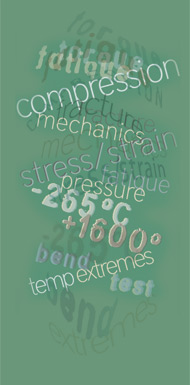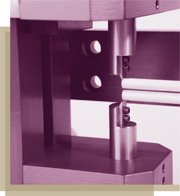

Can Epsilon extensometers be left on through
specimen failure?
Yes. All Epsilon standard extensometers are designed to withstand remaining on the sample though specimen failure. Our warranty (1 year) covers this. On certain materials, such as high strength metals, knife edges will wear out faster if the extensometer is left on through failure. A spare set of knife edges is included.
Will the extensometer be compatible with
my existing electronics?
All extensometers in this catalog can easily be shipped with the mating connector already installed, so you can plug right in to your existing electronics. We stock connectors for every common brand of test machine.
The majority of Epsilon’s extensometers are strain gaged transducers which may be connected to most brands of materials testing controls. If your controls have the signal conditioning module for a strain gaged extensometer, we can supply the unit with the necessary connector to plug in directly. If you are using a data acquisition board to acquire test data, the extensometers can almost always be interfaced properly. A few of our extensometers use capacitive sensing technology, and these include the required electronics.
If your controls are designed for LVDT type extensometers only, we can provide the electronics to work with our extensometers. Available electronics are covered here. This is also ideal for older test machines, which may not have any extensometer electronics, allowing the output to run a chart recorder or plotter, or interface to a data acquisition board.
The unique Shunt Calibration Module from Epsilon helps make calibrating the electronics for the extensometer quick and easy. This also allows you to send your extensometer back to Epsilon for periodic re-calibration. The VREF provides the same calibration function of the capacitive devices. Further details on shunt calibration or for the VREF.
What electronics are needed?
Most of our extensometers are strain gage based sensors. They use a full Wheatstone bridge design. Functionally they require the same signal conditioning electronics used for any strain gaged transducer (load cell, pressure sensors, etc.). If you do not already have the electronics, Epsilon can supply this.
How do I decide what measuring range I need?
For tensile tests on ductile materials (most metals and plastics), there is often a desire to obtain the whole stress-strain curve to specimen failure. In this case, there is a trade-off. If you specify a higher measuring range, like 50 or 100 percent strain, the accuracy of the measurements at the low end are somewhat degraded. For example, modulus of elasticity and yield strength are measured in the first few percent of the strain range, often occurring in the range of 0.1 to 2 percent strain. However, standards like ASTM E83 take this into account, since they require certain levels of accuracy expressed in percent of reading, not percent of the full scale range.
Generally speaking, Epsilon’s extensometers will meet the higher levels of accuracy requirements in today’s standards, such as ASTM class B-1. You can thus be assured that reasonably accurate measurements at the low end of the range can still be made.
For the highest accuracy of measurements like yield strength, customers often choose lower measuring ranges, such as 5 to 20 percent strain. Many modern test systems allow the user to remove the extensometer after a certain strain is reached, and use crosshead or actuator measuring range to obtain the rest of the strain data to specimen failure. This allows measurements like elongation to failure to be approximately obtained, even with a low measuring range extensometer.
Finally, it is possible to use a long measuring range extensometer and get more accurate measurements at the low end. This is done during calibration. The gain of the electronics must be adjusted to maximize the accuracy at the low end. Then at the maximum range, the error will be greater. However, the most important data is obtained at the low end of the measuring range and the accuracy for the elongation to failure measurement is not normally critical.
Why do I need an extensometer when I can get strain from crosshead displacement?
Measuring crosshead deflection during a test does not just measure strain in a defined region of a test sample. It also measures machine deflection, grip deflection and possible slippage and deflection of the part of the test sample outside the normal reduced section. Strain is defined as the change in length divided by the initial length (gauge length). There is no defined initial length without an extensometer and the change in length is not correctly measured due to the other deflections included in crosshead measuring range.



